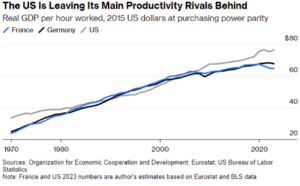"Sixteen Nobel Prize-winning economists have signed a public letter
in advance of Thursday’s presidential debate endorsing President
Biden’s economic policies and criticizing Donald Trump’s. They write:
While each of us has different views on the particulars of various
economic policies, we all agree that Joe Biden’s economic agenda is
vastly superior to Donald Trump’s. In his first four years as President,
Joe Biden signed into law major investments in the U.S. economy,
including in infrastructure, domestic manufacturing, and climate.
Together, these investments are likely to increase productivity and
economic growth while lowering long-term inflationary pressures and
facilitating the clean energy transition.
The economists support Biden’s reelection campaign and warn that
Trump’s tax-cutting proposals will reignite inflation and destabilize
the nation’s economic standing in the world. The message was drafted and
circulated by Joseph Stiglitz and signed by other luminaries, including
Edmund Phelps (Columbia University), Robert Shiller (Yale), Paul Romer
(Boston College), Angus Deaton (Princeton), Oliver Hart (Harvard), and
others. All are known as liberal or left-leaning economists with
attachments to the Democratic Party.
In 2021, 15 of these same economists, including Stiglitz, Phelps, Shiller, Hart, Romer, and Deaton, signed a similar public letter
endorsing Biden’s Build Back Better agenda, which contained spending
proposals for climate initiatives, health-care subsidies, schools,
housing, and other causes. That bill eventually passed Congress with a
$1.9 trillion price tag. Several pieces of a pared-back plan were
eventually incorporated into the so-called Inflation Reduction Act of
2022, with an estimated cost of around $800 billion. The prize-winning
economists had this to say about Biden’s economic proposals: “Because
this agenda invests in long-term economic capacity and will enhance the
ability of more Americans to participate productively in the economy, it
will ease longer-term inflationary pressures.”
The economists also claimed that Biden’s agenda includes “a broader
conception of infrastructure” that went beyond spending on roads,
bridges, and the like to include investments in human capital, research,
public education, and health care. This is a familiar Democratic Party
talking point: expenditures on various social causes are really
“investments.”
How did it all work out? The expert economists were badly mistaken on
inflation. They said that Biden’s spending packages would “ease
inflationary pressures,” but everyone understands today that those same
policies stoked inflation. When they signed their 2021 letter, the
consumer price index stood at 273; since then, it has surged by at least
15 percent, to its recent level of 313. This is called “being wrong.”
Interest rates have also surged since then, much to the detriment of
prospective homebuyers and those planning large expenditures for autos,
home appliances, and school and college tuitions. The interest rate on 30-year mortgages
has more than doubled since the 2021 letter, from 2.8 percent to above 7
percent today. The prime lending rate, used by banks for most loans,
swelled from 3.2 percent in 2021 to 8.5 percent today. The economists
would do well to ponder their performance as forecasters.
We have no evidence to suggest that Biden’s spending packages promoted economic growth. Real GDP
surged in 2021 to 5.8 percent, mostly a bounce-back from pandemic era
lockdowns, but it has declined and levelled off since then, to 1.9
percent in 2022 and 2.5 percent in 2023. In a recent forecast,
the Conference Board projects that growth in 2024 is likely to slow to
less than 1 percent (year over year). Contrary to what our Nobel
laurates would have us believe, it is more likely that Biden’s policies
have caused inflation and rising interest rates that have retarded
economic growth.
Then there is the federal debt, made worse by the Build Back Better
and Inflation Reduction Acts. When the economists signed their letter in
2021, and before the new surge in spending, total federal debt was
$28.5 trillion—an enormous sum, more or less equal to the nation’s
annual GDP. Since then, it has surged to $34.5 trillion. As a
consequence, interest payments on the federal debt have gone from around
$500 billion in total to about $1 trillion today—a $500 billion
increase in expenditures per year, expected to grow still larger year by
year as more deficits pile up.
One more thing about the misnomer called the Inflation Reduction Act,
pieces of which were endorsed by the Nobel laureates. When it was
passed in 2022, the Congressional Budget Office estimated that its
energy and climate provisions would cost $393 billion in subsidies and
tax credits. Biden and other Democrats also claimed (perhaps tongue in
cheek) that the provisions would reduce annual budget deficits in the
near term. But last year, a Goldman Sachs report
estimated that the costs of those provisions has exploded threefold, to
$1.3 trillion. According to the report, this occurred because companies
rushed in to claim tax credits that were never capped.
In sum, the Nobel laureates praising Biden’s policies today (and
criticizing Trump) are the same ones who recommended policies that
ignited inflation, drove up interest rates, wrecked the housing market,
ballooned the deficit and expenditures on interest, stifled economic
growth, and underestimated the true costs of these policies.
Judging by their track record, when it comes to economic
policymaking, these prize-winning economists have no idea what they are
talking about."
